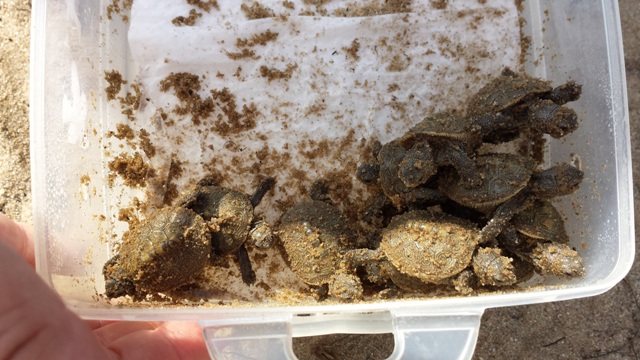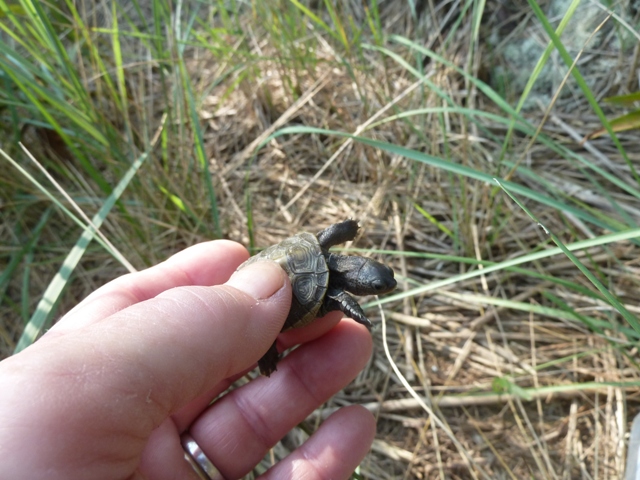There aren’t many people who can say they have watched a diamondback terrapin hatchling emerge from the nest. Usually, when our teams of volunteers go out on their shifts, if they see any hatchlings at the surface, they remove the predator excluder and dig out all the terrapins below the surface of the earth. But luckily on one Wednesday morning, I had the opportunity to watch the terrapin dig its way out.
When we first came across the hatched nest in the Westbank Turtle Garden at the sanctuary, we spotted 12 hatchlings at the surface of the ground. Some piled on each other, some casually reached their tiny clawed hands through the cage. We took the spray bottle from our turtle shift backpack and spritzed the nest with water then covered it with a towel while we went to go look for more nests.
About 35 minutes later we returned to the nest. Poking our pinkie fingers through the cage we eased the hatchlings away from the edge so we could pull off the excluder. Rebellious hatchlings disapproved of our efforts and continued to poke their heads and limbs through the fencing. As we studied the activity of the visible hatchlings, we noticed the sand in the emergence hole (where the hatchlings come out of the ground) slightly moving. It looked as though it was pulsating. We realized that there was still a hatchling making its way out! Gingerly the stakes were removed and the cage was rocked loose taking care to not injure anyone—human or chelonian.
The 12 tried to escape to safety but we scooped them all up and placed them in our turtle bucket while checking them out for physical damage. 12 perfect hatchlings. The team members brought them to the field cabin to be measured and weighed before release. Meanwhile, I stayed behind to watch the emergence.
For an hour and a half I sat and watched. My heart was pounding in anticipation as the sun beat down. The hatchling was hardly moving. It felt like I was there for days between each twitch of the sand. I was becoming uncomfortable and restless when finally the little guy broke the surface. A tiny avalanche caused his head to become buried once more. He shook off the sand and I could see the top of his head and his eyes. He blinked and gasped his first lungful of clean air.
My heart burst of emotions as I watched the new life enter the world. The scientist in me questioned his instincts and behaviors he didn’t realize he knew to do. The animal-lover in me resisted the urge to “aww” out loud. He inched his way out another centimeter and I saw the emergence of his carapace. He turned his head around in every direction looking for predators. I realized I had been holding my breath and slowly let it out being sure to not move a muscle. The minutes-old tiny terrapin crawled the rest of the way out of the nest blinking in the sunlight.
I came close to dying from an overload of cuteness until suddenly he started off in a flash! This tiny animal just having made its way out of an egg was running at full speed! I jumped up and caught him before he made it too far into the brush.
I held the little terrapin in my hands and carried him to the field cabin to join his siblings as his strong arms and legs tried to push me away. He joined the pig piles with the other 12 in the bucket and I lost him from view. He was just another tiny terrapin hatchling on a typical work day as the terrapin field assistant but he gave me a chance to see the hatching from another perspective. And it taught me a lesson in patience and field work, and it was incredible.
Leah Desrochers attended the University of New Hampshire where she graduated with a Bachelor’s of Science in Marine, Estuarine, and Freshwater Biology with a minor in Animal Behavior. After falling in love with skunks and mountain lions during a stint with the Fund for Animals Wildlife Center in Ramona, CA , she is now back in New England working with her favorite animal, making her way toward her ocean career, and saving the animals one individual at a time.






